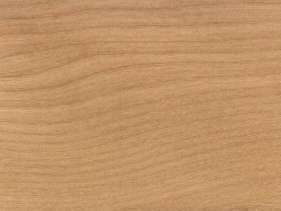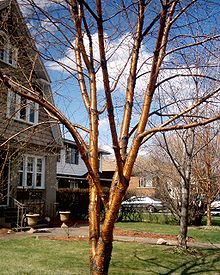Yellow Birch , presented by The Wood Explorer.
Trade Name: Yellow birch, birch. (The majority of hardwood marketed as “birch” in the United States is the species defined herein.)
Genus : Betula alleghaniensis
Janka Hardness (pounds-force): 1260
A Yellow birch in action, sharing the smooth bark with its ornamental paper birch cousin found commonly in landscape applications.
Description: Heartwood is very pale, with close to white sapwood. Figuring is common, at least from the commercially available birch that has been available to me. The grain is straight, and the pores are tight. A very hardy tree.
Location: Eastern North America. The range of the Yellow birch is roughly the same as many of the other great North American hardwoods. Ranges from Ontario and Nova Scotia to the north, and reaches to the highest elevations of the Appalachians in northern Georgia to the south.
Yeah, I built that thing. A dozen years ago. I’m no happier with its appearance than you, but it is birch. In my defense, this project was heavily subsidized by Natural Light.
Common Aliases: American birch, Betula wood, Birch. Other variations of the Genus Betula marketable as birch include: Alaska Paper Birch, Alder-leaf birch, Downy birch, Gray birch, Paper birch, River birch, Silver birch, Sweet birch, Masur birch.
Performance: Very easy to work and highly versatile. Don’t use it outside, please. You’ll be disappointed with that stunt. Yellow birch saws easily, sands and accepts finishes quite well. Birch will burn, and the burn will show if using less-than-sharp cutting heads. A great performance species for the relatively low cost. Paints well too, if you’re into that sort of thing.
Common Uses: Furnishings, veneers, plywood, doors, utility grade furnishings, millworks, dowel pins, cabinetmaking, flooring, fuelwood, toothpicks, pianos, crates.
From: The Wood Database:
Common Name(s): Yellow Birch
Scientific Name: Betula alleghaniensis
Distribution: Northeastern North America
Tree Size: 65-100 ft (20-30 m) tall, 2-3 ft (.6-1.0 m) trunk diameter
Average Dried Weight: 46 lbs/ft3 (740 kg/m3)
Basic Specific Gravity: .55
Hardness: 1,260 lbf (5,610 N)
Rupture Strength: 16,600 lbf/in2 (114,480 kPa)
Elastic Strength: 2,010,000 lbf/in2 (13,860 MPa)
Crushing Strength: 8,170 lbf/in2 (56.3 MPa)
Shrinkage: Radial: 7.3%, Tangential: 9.5%, Volumetric: 16.8%, T/R Ratio: 1.3


